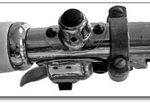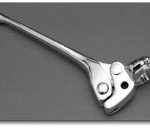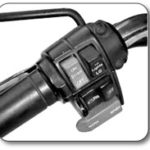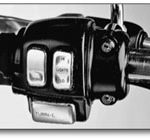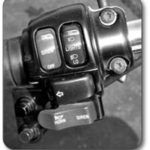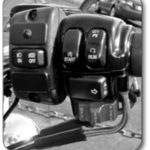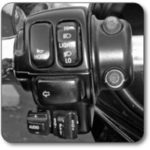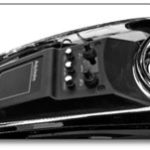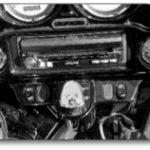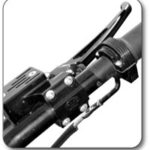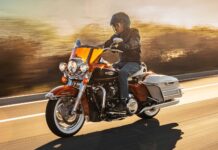You’ve gotta know that back in 1903, the term “handlebar control” had nothing to do with switches and levers. It was more like preventing tank slappers and hemorrhoids on the bumpy, solitary dirt ruts of the day. But, all good things come to an end. So it wasn’t many years later, likely about the time electric lighting took over from acetylene, that there were enough vehicles on the road for someone to decide it would be a good idea if a rider could dim his headlight when he met another one coming at him. Only neighborly, you know? Even better if one could be such a gentlemen, whilst keeping his hands firmly on the bars. Forget tipping your hat. Those damn model Ts might just swerve right into and over you! By then someone had also come up with an electric horn to warn the sleepy, sloppy car pilots. (Some things never change!) Well, nothing to do but slap a button on the bars to operate that critter, too.
So it stayed for a number of years after that. Essentially, Harleys got by nicely for nigh onto seven decades with two basic bits of apparatus festooned somewhat haphazardly to the bars—a button for the horn and a two-pole switch or two for turning on and operating the high and “dipped” beams on the headlight. There’s no doubt that in those days the layout and location of these primitive controls found their place by virtue of the logic in it. No “Guv’mint varmints” mandated it. It was, if you’ll pardon the expression, something that just evolved. If it made more sense to put that honker button where you could thumb it with the left hand, that’s where to put it, isn’t it? Literally “handy!” On the other hand (sorry, couldn’t help myself!), the rider decided as much or more about these things than the factory—or could if needed—and ergonomics be damned, as nobody even knew what that word meant back then. If you were left-handed, you might swap the buttons and switches to suit, or simply stick a button or switch under or on some part of the bike nowhere near the handlebars. (This behavior might even be the real origin of customizing—who knows?)
Want to guess when that kind of independence came to an abrupt and permanent halt? Well, one could speculate that it was when The Motor Company decided it was time to add electric starting to the 12-volt repertoire of the venerable Panhead in 1965. I mean, the added starter button was identical to the horn button in those days—one on the left, one on the right, but still swappable. Not that you’d ever want to.
Not so with turn signals! So, my money is on turn signals. They were one of the first “federally mandated” devices we got stuck with. (Thus are freedoms eroded… and controls standardized.) It’s no accident that Harley’s “hand clusters” of control buttons and switches, uniquely left and right, began in 1972. Turn signals became the law of the land exactly one year later.
Since then, the designs, devices, even the philosophy of proper handlebar controls have ebbed and flowed from the logical to the ridiculous. But, those basic “hands on” functions we’ve grown to know and love remain much the same as they were when Nixon was boss. There are buttons for starting, switches for stopping, horns to honk, blinkers to blink, brake lights to light, and more. Today, we still control whether we choose to blind the goon coming at us, but sadly we have no choice when it comes to turning off the headlight altogether. Good news, bad news, whichever side you’re on; there are reasons for all of it. Some are pretty darned entertaining. C‘mon, let’s see if any of these buttons or switches turn you on.
1. It doesn’t get much simpler than this! Nor much older, come to think of it. This basic button mounts directly to the bars and dates back to at least 1926. It’s equally happy operating the horn, starter or any other old thing that deserves a little push. Practically, the button’s equal for sheer simplicity is this two-pole switch. Mounts the same way—drill holes, screw on bars, operate device. Duh… since 1929, no less! If you needed more than one of them, you added. No labels, no organization—simple anarchy that the rider had to memorize to operate.
2. In elegant combinations, these old timers aren’t bad at all. Cleaner than clusters! The trouble arises when you add passing lamps and other electrical nonessentials. These somewhat bulky designs take up some relatively valuable real estate on the handlebar, and it’s one switch assembly to each device as well. You can see the limits, and the poor ergonomics, if you add too much stuff that needs switching.
3. Control buttons and switches were an independent notion from the control levers for a long time, too. In the days of the drum brake, you could even get away with swapping the clutch/brake levers from side to side. (Clutch operations were a higher priority than front brakes, in the event you… ahem!… broke one.)
4. All that changed in 1972. We are suddenly offered “integrated” switch clusters, as in “it’s all in one basket” (or box… if you prefer) and incorporating the mounts for the levers. All neatly organized, labeled and (surprisingly) still offering a certain amount of latitude to the owner/operator. Meaning—the tiny switches under those buttons were all the same and the labels stuck on the housings could be moved around, or dispensed with altogether. Therefore, at the rider’s discretion, certain functions could be moved to different positions (like swapping the horn button to a spot closer to your thumb, if you weren’t running turn signals) which is more than you could manage with what came next…
5. …like the “improved” arrangement we got in 1982. No foolin’ around here! These switches and buttons are specific and unchangeable. Nor could one buy just one if that’s all that failed or fouled up. No, you’ve got to replace the “assembly,” cause it is what it is. Another notable foible of this design is the location of the horn button (inboard), so you had to reach your thumb across the high/low headlight switch to honk at morons in cages—emergency or otherwise. Neither ergonomic nor safe, in my opinion. ’Course I might be biased, having on more than one tense occasion merely flashed the object of my intentions when I meant to be horny.
6. Cops got even more complexity with their switches because they had more stuff to control, such as sirens, which required no less than two extras—turning the thing off or on—and then operating it. The good news is the horn button is a hell of a lot more logically located and the turn signal switches are simple on/off rockers. No automatic canceling here!
7. The right side control switches get an extra function, too—namely, some mysterious activity known as “pursuit”… how en“light”ening!
8. I vividly recall my first encounter with the revised design of these 1996-to-date controls—at the dealer show in San Diego in the fall of 1995. Both clusters were immersed in a huge fish tank, presumably to demonstrate that the big news, aside from the restyle (and relocated horn button) was they were waterproof.
9. As usual by now, police bikes get more switches as well as the occasional extra button or two, as seen here. Seems to me, we’ve gotten to the point where we’re expecting a lot from those infamous opposable thumbs that separate us from lower life forms. And, lord help you, if you need to do too many things at once—and you’re all thumbs!
10. Good Grief! What is that doo-dad inboard of the regular switches on the right hand cluster of this police bike? Hey—all I know is it’s got an extra on/off switch the officer must use—off and on.
11. Not that the police have anything on a civilian bagger rider with a taste for long, boring, lonely trips and kickin’ tunes. I mean, look at all those buttons and switches! Haven’t we come a long way from jukeboxes and “dead man” throttles? Do we really need to bring along electronic versions of both those things every time we ride?
12. Come think of it, we’ve managed to add so many “features” to our machines we need more buttons and switches than we can stick on handlebars! So we move some to the gas tank? Geez!
13. How about sound systems and passing lamp switches and “auxiliary” this and that—out the wazoo? Clear up on the fairing! I’m not sure a normal human could even monitor all this (gauges included) let alone control things this complex.
14. Maybe that’s why—when it’s all switched off and buttoned up—I find the bone-clean simplicity of this handlebar (lack of) cluster so refreshing! In the end—when the ride is for the ride’s sake—it all comes back to basics. This (switch-less on both sides) arrangement is an elegant, stark reminder of that fact.




